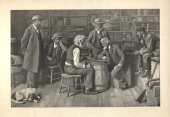The Checker Maven
The World's Most Widely Read Checkers and Draughts Publication
Bob Newell, Editor-in-Chief
Published each Saturday morning in Honolulu, Hawai`i
Contests in Progress:
No Work Today: A Midweek Bonus Problem
It's stormy today (March 15, 2005) in the mountains of New Mexico and our office has been closed for two days straight. Although The Checker Maven usually publishes on weekends, today is special, and we invite you to warm by the fire with this midweek bonus problem.
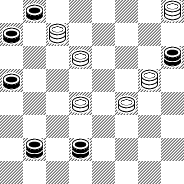
WHITE
White to Play and Win
Avoidance Maneuver
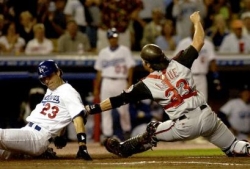
Here's the layout:
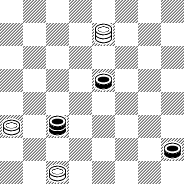
WHITE
White to Play and Draw
Who is Your Favorite Checker Book Author?

Through the history of the game, many books have been written and many authors have tried their hand, some with great success and others with less spectacular results. And so, we'd like to ask our readers a question: who is your favorite checker book author?
In this survey, we've listed a few of the most prolific and well-respected authors. Which one do you enjoy reading the most? Enter your vote and then compare it with the choices of other readers.
Two More Easy Pieces
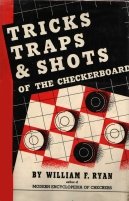
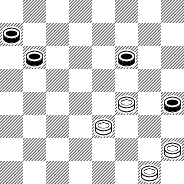
White to Play and Win
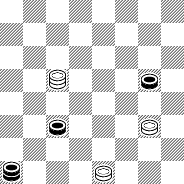
White to Play and Win
March Speedsters

No. 1. Very easy.
No. 2. Easy.
After you've solved them, click on Read More to check your answers.
There's the green flag ..... go!
[Read More]Introducing Marvin J. Mavin
We'd like to introduce you to Marvin J. Mavin, the hero of this webzine and the Captain and First Board player for the Detroit Doublejumpers, one of the leading teams in the Central Division of the National Checker League.

Marvin J. Mavin
Captain, Detroit Doublejumpers
Marvin was a top player on his grade school and high school teams, being named to the All-State squad three years running in his home state of New Jersey. He moved on to collegiate checkers, receiving a full-ride scholarship from the prestigious University of Champions in Mississippi. Following college he was a first-round draft choice of the St. Louis Switchers, who started him out with their Triple-A farm club, the Louisville Leapers of the Southeastern Checker League.
Marvin made the "big show" within a year, moving up to the Switchers, but became a free agent after his two-year contract expired, as he and the Switchers were unable to come to terms, with Marvin asking $12 million a year and the Switchers capping their offer at $8 million. The Doublejumpers then signed him on for $10 million per year plus performance based bonuses. The rest, as we all know, is history.
Join us in the columns of The Checker Maven later this month (March 2005), as Marvin pays a visit to a Detroit grade school and gives a lesson (or perhaps gets a lesson) on the "Fun Shot" in the Single Corner opening.
Checker Maven Score Sheets
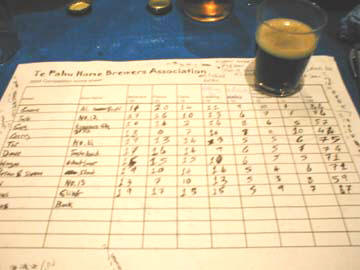
You can get them here. Let us know what you think.
Oh...yes, these are for checkers, in case you were wondering!
Life Is Full of Tough Choices
The last offering for February is two problems in one. It's based on something published by Willie Ryan many years ago. The adaptation of the setting is rather liberal.
Here's the situation. You're in the final round of the Mega-Bowl of Checkers. The coveted title of Supreme Exalted Checker Champion hangs in the balance. Thousands of avid fans are watching from their $500 stadium seats and hundreds of thousands more are tuned in on the Checker Television Network. Sponsors have paid a million dollars each just for their 30-second commercial spots. This is really the Big Time, and you know if you win you'll become an instant media star, with wealth and fame yours without limit.
You're playing Black and it's your move:
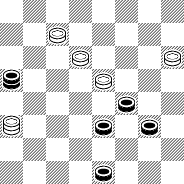
BLACK (you)
What move do you choose? Can you show how that move wins and why the other move loses?
Make your choice carefully; a lot is riding on it. Then take a look at the animated solutions in which Black wins or White wins.
A New and Original Online Play Site
We've come across what must be a fairly new site but one that has really captured our attention. It's called TurnPlay and it's simple, focused, and unique. This site has a lot of promise and we hope that it attracts its share of users. It is sure to appeal to the serious checker player.

TurnPlay is not a site for a casual head-to-head "pickup" game. It is instead a site which you can use to establish games with other players, who don't even have to be members themselves, and then engage in serious play backed by a game moderation system that works the way it ought to, including the use of correct PDN for moves.
In addition, the site allows for setup and play of an arbitrary position, something we have yet to see elsewhere.
Memberships are inexpensive at $20 per year although free guest memberships offer many of the important features, including unlimited play.
Check out the review and then check out the site. And if you like it, support them by joining.
Addendum
We did, by the way, also just now review another site which offers email turn-based play of something they believe to be checkers (although we beg to differ). We won't embarrass them, or us, by mentioning its name in The Maven, but the full review is here if you'd like to see for yourself.
Update
Missing screen shot images for about half a dozen sites on the review page have been restored as of 05 March 2005; our apologies for any inconvenience.
Computer Cheating in On-Line Checkers
We received this email today:
"I see a lot of people using a Cheating program for playing checkers on Yahoo. Where are they getting it from? Thanks"

It's pretty sad, isn't it? We can only hope that some day, these folks might get a life and realize that there is no shame in losing with grace and sportsmanship, and that relying on your own skills and accepting the results is what makes a true winner.
[Read More]The Checker Maven is produced at editorial offices in Honolulu, Hawai`i, as a completely non-commercial public service from which no profit is obtained or sought. Original material is Copyright © 2004-2024 Avi Gobbler Publishing. Other material is the property of the respective owners. Information presented on this site is offered as-is, at no cost, and bears no express or implied warranty as to accuracy or usability. You agree that you use such information entirely at your own risk. No liabilities of any kind under any legal theory whatsoever are accepted. The Checker Maven is dedicated to the memory of Mr. Bob Newell, Sr.

